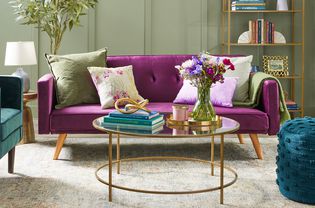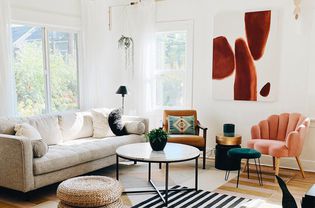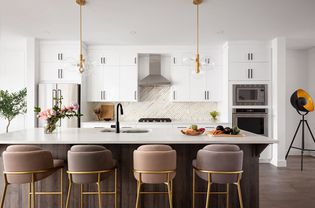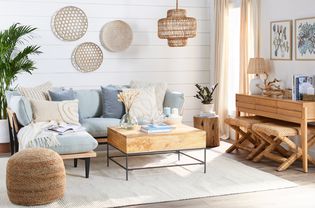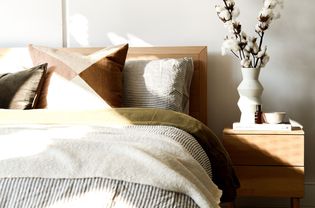Are you familiar with the 60-30-10 color rule? Odds are you’ve witnessed this philosophy at play, even if you can’t identify it by name. The rule essentially concerns striking a balance in terms of colors so that 60 percent of the room contains one color (your primary hue), 30 percent is another color (your secondary hue), and the remaining 10 percent is an accent color.
“This rule isn’t an exact science, but it’s a good guideline when planning your color scheme,” designer Heather Kirk explained in an email. “By keeping your colors in this ratio, it keeps things from feeling off balanced or too chaotic.”
Kirk shared her tips for those seeking to design a space using this guideline. “Start with the feeling you want to create in a space, how you use the space and the permanence of the materials,” she said. “It’s much easier to change your sofa pillows than it is to change a kitchen backsplash, so move forward with this rule and enjoy the colors you love.”
Below, we’re sharing five spaces by Kirk and other designers that demonstrate just how successful the 60:30:10 color rule can be in shaping a room.
Kitchen
:max_bytes(150000):strip_icc()/KirkRileyDesignbyJulieMannellPhotography1-92bba951295a4199918a1d7514829c2f.jpg)
Kirk Riley Design / Julie Mannell Photography
Kirk explained that when designing a kitchen like the one pictured here, the cabinets consist of 60 percent, or “the bulk of the color palette” and supporting colors come through in the form of walls, floors, or countertops. When it comes to the 10 percent, “think about the final touches in space,” Kirk noted, highlighting accessories and hardware as examples. She explained, “This kitchen has white cabinetry and backsplash: Hello, 60 percent. Next, we have some dramatic color with black cabinets, hardware, and lighting. We round out the combination with blue on the decorative backsplash tile and accessories.”
Bathroom
:max_bytes(150000):strip_icc()/KirkRileyDesignbyJulieMannellPhotography2-0e18f327ad0d403785efe04c2ab94547.jpg)
Heather Kirk / Julie Mannell Photography
Kirk also successfully implemented the color rule when designing a bathroom—here, the question was “how to have a bright and fresh looking bathroom and not have it feel too sterile,” she explained. “Start with bright white and glossy tile, a true classic,” advised Kirk, referring to her 60 percent. “Next we need to anchor the white with color—maybe choose your favorite color,” she offered. “We worked with our client in selecting a gray here as the 30 percent with the cabinetry and a lighter version on the flooring.” Last but not least, Kirk added black accents. She said, “The black is the balance the white and gray needed so it felt cloud-like, but with dimension and details.”
Family Room
:max_bytes(150000):strip_icc()/KristicourtesyofHapiArt.-6199d5d9df994d21b780acc42d0cb51c.jpg)
Color expert and artist Kristi Kohut greatly enjoys pairing deep blues with pops of warm colors. “I thought, ‘Why not bring this dynamic duo into my own home when redesigning our family room,’” she reflected in an email. “The 60-30-10 rule is such a great way to make sure the balance is right,” she added. “Following this, I started with a rich navy for the main color, along with complementary blues in other key pieces throughout the room.” Because Kohut loves the combination of navy and pink, she incorporated this into her space and then wove in striped pillows and artwork to tie the look together. “The hints of yellow in the pillows and artwork add that finishing touch,” she said. That said, Kohut noted that one doesn’t need to follow the 60:30:10 rule with precision to create a space that shines. “Rather, use it as a general guide,” she explained. “Use your intuition and fill your space with art and accessories that really speak to you, and they will bring you joy every time you walk into the room.”
Bedroom
:max_bytes(150000):strip_icc()/RoseStudioInteriorsbyCarlaChoyPhotography-992365b8879e4f9db7af7ba954cf8bdd.jpg)
Rose Studio Interiors / Carla Choy Photography
The rule applies to sleep spaces, too, said San Diego designer Jessica Rose of Rose Studio Interiors. “The 60-30-10 color rule is an important one to follow in places of relaxation in hospitality design,” Rose explained in an email. She suggests incorporating a variety of comfortable neutral pieces featuring different textures while adding “a pop of color repeated in different materials to draw the eye in.” Don’t neglect the seemingly small details, either, Rose noted. “Adding smaller elements of metal or shine in fixtures and hardware completes the look,” she said.
Or, Think Consider the Rule of Three
:max_bytes(150000):strip_icc()/DebbiePerezbyGabrielBurgos-f79514864f8f415aa117df5d04c34a8e.jpg)
Debbie Perez / Photo by Gabriel Burgos
Tampa designer Debbie Perez is also a proponent of the 60:30:10 color rule but noted, “I think of this rule more in terms of threes.” Perez explained in an email, “The end result is essentially the same: to balance the color in a space to keep things interesting.” Perez noted that when designing the living space pictured here, she was most primarily inspired by the blue water out the window. “When you have a view of the water, it’s all about the water,” she added. “Gray, brown, and white are neutral enough colors to allow the blue of the water to pop!” White, the main color, makes up 60 percent of the room, and we see the hue in terms of the wall color, media display and built-ins, corals, accessories, and lamp shades. Gray, which makes up 30 percent of the space, is present in terms of the accent chairs, rug, sofa, pillows, and art, while brown accessories comprise the remaining 10 percent.

